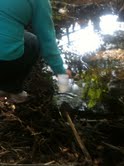In this picture one of the students in my Grade 5/6 practicum class is releasing a coho salmon fry. We had been raising these fish in the classroom since January and it was time to release the salmon. This reflection is not about the overall experience of releasing the salmon instead it is about my interactions with one student with Asbergers syndrome and the way that I was able to help him to be included within the class excursion.
This story begins after we arrived in Stanely Park to release the salmon. The sponsor teacher began by going over the steps involved in releasing the salmon. Each student had to walk down to the side of the creek holding the salmon in a full glass of water. They had to hold the glass of water under the stream and slowly allow the salmon fry to get used to the temperature difference and then after a couple of minutes release it. I waited down by the stream to release the salmon and I did not notice the commotion in line. Some of the students in the class had begun to tease Bobby* about his backpack which they said was a child’s backpack. By the time it was his turn to release the salmon he was crying. He walked down to the river and I tried to help him but instead he began yelling and he threw the entire cup into the water. I quickly walked him away from the larger group and had him regulate his breathing to reduce his anxiety. I then put his backpack inside mine so the other students couldn’t see it anymore. Next I worked with him to create a signal that he could use if he became agitated. I told him that if I was near him he could tap me on the shoulder and if I was far away he could wave his hand. We went back to the larger group and for the rest of the day he was able to participate in the field trip without becoming visibly upset or anxious. When we arrived back at school I heard him say to another student that he had a wonderful field trip.
This artifact is evidence that I have met Standard 2: Educators Value and care for all students and act in their best interest. This experience was significant because it illustrates the way that as a teacher I enable inclusiveness in the classroom. For Bobby this field trip could have easily been ruined. If he was unable to calm down or the students persisted in teasing him he would have had to be separated from the larger group and not participated for the remainder of the day. Through using techniques such as modeling breathing, giving him a signal to use and hiding the backpack I was able to ensure that he could participate in the field trip after this incident. As a teacher I feel that one of my primary responsibilities is to ensure that every student is able to participate in the classroom and be part of the classroom community. This is particularly important when students might be excluded because of they have a way of participating that is different from others.
In my future teaching practice I will continue to develop strategies that allow me to help defuse situations such as the one described above and in doing so make the classroom a more inclusive place. I hope to enhance this aspect of my teaching practice by, observing other teachers and classroom assistants, attending professional development workshops and by working with the learners themselves and figuring out which strategies work for them.
